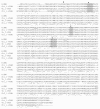Cloning and functional characterization of a fructan 1-exohydrolase (1-FEH) in edible burdock (Arctium lappa L.)
- PMID: 21463533
- PMCID: PMC3080278
- DOI: 10.1186/1752-153X-5-16
Cloning and functional characterization of a fructan 1-exohydrolase (1-FEH) in edible burdock (Arctium lappa L.)
Abstract
Background: We have previously reported on the variation of total fructooligosaccharides (FOS), total inulooligosaccharides (IOS) and inulin in the roots of burdock stored at different temperatures. During storage at 0°C, an increase of FOS as a result of the hydrolysis of inulin was observed. Moreover, we suggested that an increase of IOS would likely be due to the synthesis of the IOS by fructosyltransfer from 1-kestose to accumulated fructose and elongated fructose oligomers which can act as acceptors for fructan:fructan 1-fructosyltransferase (1-FFT). However, enzymes such as inulinase or fructan 1-exohydorolase (1-FEH) involved in inulin degradation in burdock roots are still not known. Here, we report the isolation and functional analysis of a gene encoding burdock 1-FEH.
Results: A cDNA, named aleh1, was obtained by the RACE method following PCR with degenerate primers designed based on amino-acid sequences of FEHs from other plants. The aleh1 encoded a polypeptide of 581 amino acids. The relative molecular mass and isoelectric point (pI) of the deduced polypeptide were calculated to be 65,666 and 4.86. A recombinant protein of aleh1 was produced in Pichia pastoris, and was purified by ion exchange chromatography with DEAE-Sepharose CL-6B, hydrophobic chromatography with Toyopearl HW55S and gel filtration chromatography with Toyopearl HW55S. Purified recombinant protein showed hydrolyzing activity against β-2, 1 type fructans such as 1-kestose, nystose, fructosylnystose and inulin. On the other hand, sucrose, neokestose, 6-kestose and high DP levan were poor substrates.The purified recombinant protein released fructose from sugars extracted from burdock roots. These results indicated that aleh1 encoded 1-FEH.
Figures





Similar articles
-
Fructan Structure and Metabolism in Overwintering Plants.Plants (Basel). 2021 May 7;10(5):933. doi: 10.3390/plants10050933. Plants (Basel). 2021. PMID: 34067059 Free PMC article. Review.
-
Purification, characterization, and functional analysis of a novel 6G&1-FEH mainly hydrolyzing neokestose from asparagus.J Exp Bot. 2018 Aug 14;69(18):4295-4308. doi: 10.1093/jxb/ery234. J Exp Bot. 2018. PMID: 29931209
-
Purification, cloning and functional characterization of a fructan 6-exohydrolase from wheat (Triticum aestivum L.).J Exp Bot. 2006;57(1):213-23. doi: 10.1093/jxb/erj031. Epub 2005 Dec 5. J Exp Bot. 2006. PMID: 16330524
-
Cloning, gene mapping, and functional analysis of a fructan 1-exohydrolase (1-FEH) from Lolium perenne implicated in fructan synthesis rather than in fructan mobilization.J Exp Bot. 2007;58(8):1969-83. doi: 10.1093/jxb/erm053. Epub 2007 Apr 24. J Exp Bot. 2007. PMID: 17456505
-
Burdock (Arctium lappa L) roots as a source of inulin-type fructans and other bioactive compounds: Current knowledge and future perspectives for food and non-food applications.Food Res Int. 2021 Mar;141:109889. doi: 10.1016/j.foodres.2020.109889. Epub 2020 Nov 10. Food Res Int. 2021. PMID: 33641945 Review.
Cited by
-
Characterization of the Tibet plateau Jerusalem artichoke (Helianthus tuberosus L.) transcriptome by de novo assembly to discover genes associated with fructan synthesis and SSR analysis.Hereditas. 2019 Feb 6;156:9. doi: 10.1186/s41065-019-0086-8. eCollection 2019. Hereditas. 2019. PMID: 30774580 Free PMC article.
-
Development of rubber-enriched dandelion varieties by metabolic engineering of the inulin pathway.Plant Biotechnol J. 2017 Jun;15(6):740-753. doi: 10.1111/pbi.12672. Epub 2017 Feb 9. Plant Biotechnol J. 2017. PMID: 27885764 Free PMC article.
-
Fructan Structure and Metabolism in Overwintering Plants.Plants (Basel). 2021 May 7;10(5):933. doi: 10.3390/plants10050933. Plants (Basel). 2021. PMID: 34067059 Free PMC article. Review.
-
Cloning and functional characterization of two abiotic stress-responsive Jerusalem artichoke (Helianthus tuberosus) fructan 1-exohydrolases (1-FEHs).Plant Mol Biol. 2015 Jan;87(1-2):81-98. doi: 10.1007/s11103-014-0262-1. Epub 2014 Oct 22. Plant Mol Biol. 2015. PMID: 25522837
References
-
- Suzuki M. In: Science and Technology of Fructans. Suzuki M, Chatterton NJ, editor. CRC Press, Boca Raton, FL; 1993. Fructans in the crop production and preservation; pp. 227–255.
-
- Edelman J, Jefford T. The mechanism of fructosan metabolisim in higher plants as exemplified in Helianthus tuberosus. New Phytol. 1968;67:517–531. doi: 10.1111/j.1469-8137.1968.tb05480.x. - DOI
-
- Shiomi N, Izawa M. Purification and characterization of sucrose:sucrose 1-fructosyltransferase from the roots of asparagus (Asparagus officinalis L.) Agr Biol Chem. 1980;44:603–614.
-
- Koops AJ, Jonker HH. Purification and characterization of the enzymes of fructan biosynthesis in tubers of Helianthus tuberosus Colombia. II. Purification of sucrose:sucrose 1-fructosyltransferase and reconstitution of fructan synthesis in vitro with purified sucrose:sucrose 1-fructosyltransferase and fructan:fructan 1-fructosyltransferase. Plant Physiol. 1996;110:1167–1175. - PMC - PubMed
LinkOut - more resources
Full Text Sources
Research Materials
Miscellaneous

